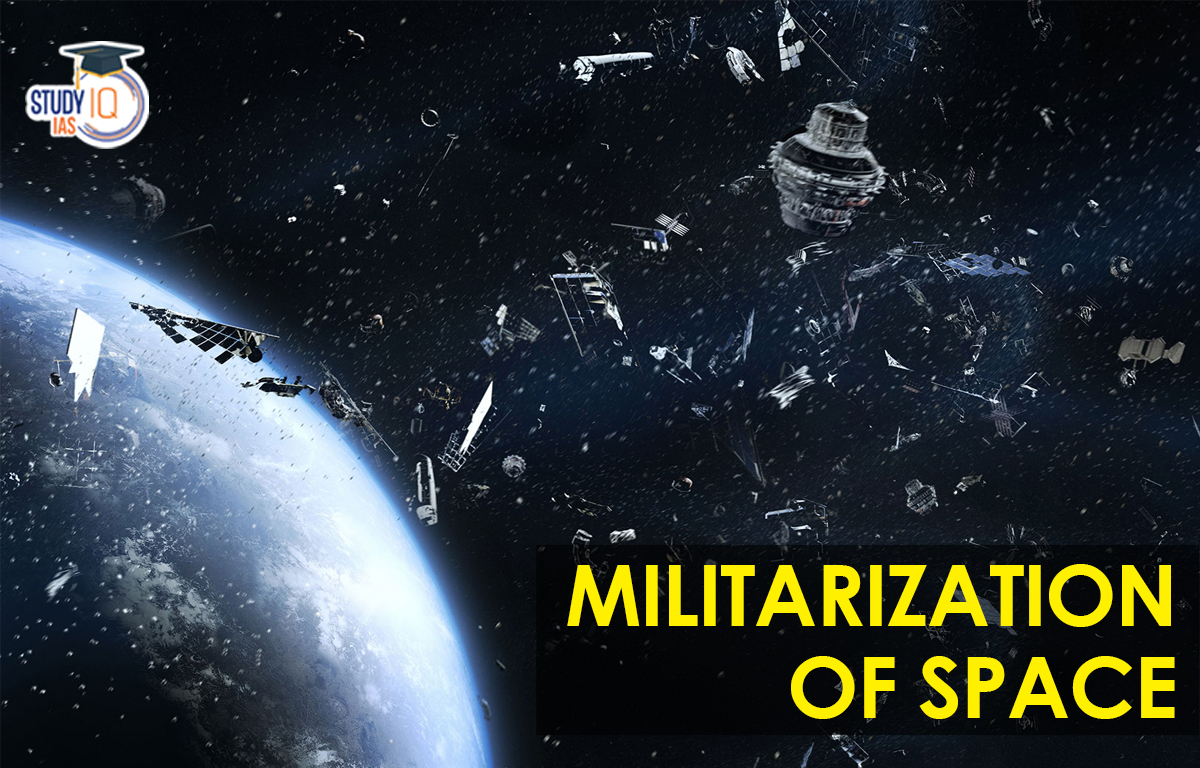Table of Contents
Context : Recent Reports have suggested that militarization of space by various countries have increased the risk of a potential war in space, thereby, necessitating the need for international cooperation and regulations to prevent the same.
What is Understood by Militarisation of Space?
- The militarization of outer space refers to the use of space technology, infrastructure, and assets for military purposes. This includes the deployment of military personnel and equipment in space, the development and deployment of space-based weapons systems, and the use of space assets for intelligence, surveillance, and reconnaissance (ISR) activities.
- Space warfare involves combat outside the Earth’s atmosphere, including ground-to-space warfare (attacking satellites from the Earth) and space-to-space warfare (satellites attacking other satellites). However, it does not encompass space-to-ground warfare, where orbital objects attack the Earth’s surface.

Recent Developments in Militarization of Outer Space
India:
- In 2019, India also established two new bureaucracies for space, the Defence Space Research Organization (DSRO) and the Defence Space Agency (DSA).
- Conducted first ever simulated space warfare exercise, IndSpaceX, in 2019
- Successfully tested anti-satellite weapon, Mission Shakti, in 2019 and Launched the tri-service Defence Space Agency (DSA) and Defence Space Research Agency (DSRA)
- Recognized space as a military domain as much as land, water, air, and cyber and Approved creation of IN-SPACe in 2020, an independent nodal agency under the Department of Space to encourage private participation in the space domain
China:
- Building Tiangong Space Station in low Earth orbit
- Plans to establish its permanent presence on the Moon by 2024 in Cis-Lunar space
- Making serious advances in weaponizing outer space and creating the fourth frontier of war in space by making strides in its ICBM program
United States:
- In July 2019, the US Space Command named Space Force to strengthen its war-fighting capabilities, it was established as the sixth branch of the US military, indicating the growing importance of space as a domain for military operations.
- In August 2020, the US Department of Defense released its Space Capstone Doctrine, which outlined its strategy for space operations, including the use of space-based weapons for self-defense and deterrence.
- In addition to these efforts, the US has been closely monitoring developments in other countries, particularly China, which has been rapidly developing its space capabilities and is seen as a potential competitor in the space domain.
Russia:
- Russia has been developing its military space capabilities with recent developments including a successful test of its Nudol anti-satellite missile system, new satellite jammers capable of disrupting GPS and other navigation systems, a planned launch of a new military satellite, and development of the Orel spacecraft for lunar exploration.
- Additionally, Russia is expanding its military presence in the Arctic, announcing plans to deploy surface-to-air missile systems to protect its military bases.
Challenges posed by Militarization of Outer Space
- Arms race: The militarization of space has the potential to lead to an arms race, as countries compete to develop new technologies and weapons systems. For example, India and China both conducted successful anti-satellite missile tests in 2019, fueling concerns about an arms race in outer space.
- Increased conflict and instability: The militarization of outer space can increase the likelihood of conflict and instability, as countries compete for dominance and resources. For example, the development of China’s anti-satellite missile program has raised concerns about the potential for conflict with the United States and other countries.
- China’s expanding Influence : The Chinese space industry is evolving rapidly, and China has established a strong presence in the space domain. China’s Belt Road Initiative (BRI) members are likely to contribute to or join the Chinese space sector, solidifying China’s global position.
- Rising Space Debris: Increasing outer space expeditions are increasing space debris, which can impact ongoing and future space missions. Collisions with even small pieces of space debris can damage spacecraft and lead to ozone depletion. For example, in 2007 China destroyed one of its own weather satellites, generating over 3,000 pieces of debris larger than 10 cm in diameter.
- Rising Commercialization of Outer Space: The commercialization of outer space is increasing through private satellite expeditions for transmitting internet services and space tourism. For example Axiom Space launched its first fully private commercial mission to space in 2022 onboard SpaceX’s Crew Dragon Capsule.
- Diversion of Resources : The development of space-based weapons and military technologies requires significant resources and funding, which can divert resources away from other important areas. For example, the United States Space Force has a budget of approximately $15 billion, which some argue could be better spent on other priorities.
- Global commons under threat: The destruction of communication satellites by anti-satellite missiles poses a threat to global navigation and communication networks. For example, in 2007, China used an anti-satellite missile to destroy one of its own aging weather satellites,
- Possibility of Monopolizing Orbital Slots: Countries deploying military satellites are reluctant to disclose their orbital slot and radio frequency, leading to the possibility of monopolizing orbital slots in the future. For example, in 2016, the United States accused Russia of violating a 1987 arms control treaty by testing an anti-satellite missile.

India’s stand on the militarization of outer space: India’s stand on the militarization of outer space is focused on peaceful utilization of space and safeguarding the security of space-based assets. Here are the key points that explain India’s stance:
- India is against the weaponization of outer space and supports international efforts to reinforce the safety and security of space-based assets. India believes that outer space is the shared heritage of mankind, and it is the responsibility of all space-faring nations to safeguard and foster the benefits flowing from space technology and its applications for all.
- To this end, India has implemented several Transparency and Confidence Building Measures (TCBMs), including registering space objects with the United Nations (UN) register, pre-launch notifications, measures in harmony with the UN Space Mitigation Guidelines, participation in Inter-Agency Space Debris Coordination (IADC) activities concerning space debris management, undertaking SOPA (Space Object Proximity Awareness and COLA (Collision Avoidance). India also takes part in all sessions of the UN Committee on the Peaceful Uses of Outer Space.
- India supported the UNGA resolution 69/32 on No First Placement of Weapons in Outer Space India supports the substantive consideration of the issue of Prevention of an Arms Race in Outer Space (PAROS) in the Conference on Disarmament, where it has been on the agenda since 1982.
- Recently to safeguard national interests India’s stance has been evolving, it emphasizes the need to enhance space situational awareness capability and safeguard assets with counter-space capabilities while building resilience and redundancy in a space-based infrastructure. India is exploring the field of miniaturization of satellites and reusable launch platforms to mitigate cost, challenges and accelerate the pace of augmenting India’s space-based capabilities.
Global frameworks that Influence the Weaponization of Outer Space
Outer Space Treaty (OST) of 1967 –
- The OST has been ratified by 110 countries including India and is considered the cornerstone of international space law. It is the basis of international space law and prohibits the placement of weapons of mass destruction in outer space. it establishes outer space as a global commons, open to exploration and use by all nations, but not subject to national sovereignty.
- It prohibits the placement of nuclear weapons or other weapons of mass destruction in space and establishes the principles of peaceful exploration and use of space. The treaty also requires that states are responsible for their national activities in space.
Other Major Framework Include:
- Convention on Registration of Objects Launched into Outer Space (1975) – This convention requires space-faring nations to register their space objects with the UN.
- Treaty on Principles Governing the Activities of States in the Exploration and Use of Outer Space, including the Moon and Other Celestial Bodies (1979) – This treaty expands upon the Outer Space Treaty by prohibiting the testing and deployment of any type of weapon in outer space.
- Missile Technology Control Regime (MTCR) – This is an informal multilateral export control regime that aims to prevent the proliferation of missiles and other delivery systems for weapons of mass destruction.
- Hague Code of Conduct Against Ballistic Missile Proliferation (2002) – This is a voluntary code of conduct that seeks to prevent the development, testing, and deployment of ballistic missiles.
- The Prevention of an Arms Race in Outer Space (PAROS) – This is a UN agenda item that seeks to negotiate a legally binding instrument to prevent the weaponization of outer space.
- International Code of Conduct for Outer Space Activities (ICOC) – This is a proposed code of conduct that aims to promote responsible behavior in space and prevent the weaponization of outer space.
Way forward: It is important to emphasize the need for peaceful and responsible use of outer space while addressing the issue of militarization. Possible way forward for militarization of outer space:
- Capacity Building for Space Warfare: India needs to enhance its space capabilities through research and development. KALI is being designed as a potential response to incoming missiles, with the aim to disrupt the country’s peace. India-US joint military exercises can further enhance its defence partnership.
- Attracting Global Market for Space Exploration: India can leverage its local market conditions such as talent pool, low labour costs and engineering services to replicate cost-competitive world-class products and services for the space market. The success of the Mangalyaan mission can help India integrate into the global supply chain.
- Developing Space Asset Security Infrastructure: India needs reliable and accurate tracking capabilities to defend its space assets, including debris and spacecraft. Accurate tracking is vital for almost every conceivable space action. Project NETRA, an early warning system to detect debris and other hazards, is a step towards developing this capability.
- Global Governance of Global Common: Outer space is a common heritage and asset owned equally by every human being. Modern global economies rely heavily on space assets such as the GPS, telecom networks, early warning systems and weather forecasts. It is important to scrutinize the issue of militarization at global multilateral forums and develop legally binding instruments to prevent an arms race and fill any legal gaps.


 Nipah Virus (NiV): Structure, Testing Me...
Nipah Virus (NiV): Structure, Testing Me...
 Elon Musk’s America Party: A New Chapt...
Elon Musk’s America Party: A New Chapt...
 India and Trinidad and Tobago: Strengthe...
India and Trinidad and Tobago: Strengthe...





















